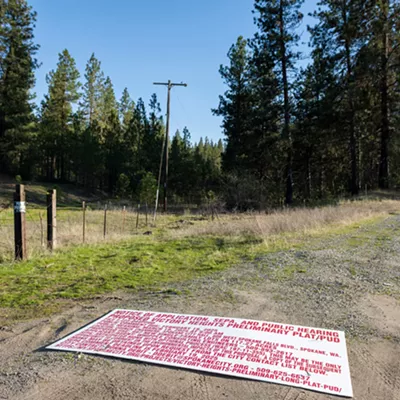I'll never forget the first time I saw a Patti Warashina teapot. It was at Gonzaga University's Jundt Art Museum, and if I remember correctly it was part of a "Spokane Collects" exhibit curated from the private collection of Jim Kolva and Pat Sullivan. Instead of the familiar and functional roundness, Warashina's teapot was in the sleekly planed contours of a woman's face, the arched eyebrows and puffed cheeks all following an invisible line that pulled the viewer's eye inevitably toward the piece's punch line: the playfully profane spout -- a pair of pursed, muscular lips.
The internationally recognized Seattle artist has moved far beyond her anthropomorphic teapots, but her work still has a way of burrowing itself into a viewer's consciousness. The Warashina vessel is the only one I remember with any clarity from that show, and her newer figures -- elongated human forms on tall steel stands -- are similarly disturbing, witty and full of an uneasy beauty.
The Jundt Art Museum hosts a major show of Warashina's work, beginning Oct. 22. For Inland Northwest audiences, it's on opportunity to meet one of the legendary figures in Pacific Northwest art. Born in Spokane in 1940, Masae Patricia Warashina was the youngest of three kids born to a Japanese emigrant father and a second-generation Japanese-American mother. She went to the University of Washington for both her BFA and MFA degrees and studied with some of the leading names in the contemporary ceramics movement, including Robert Sperry, Rudy Autio, Ruth Pennington and Shoji and Shinsaku Hamada (who were bringing a Japanese aesthetic to American studios).
Warashina's early influences included the California Funk movement and surrealism; her later pieces exist in the intersection of semantics, pop culture, narrative and the dream state. Recent series, including "Real Politique" and the "Mile Post Queen" series, consist of bone-thin human figures on tall steel bases, their ectomorphic forms bringing to mind the regally minimalist representations of ancient Egyptian royalty. Exclamation points, spools of thread, duck decoys and spiky flames come out the tops of heads; the graceful bodies provide balance and calm below. In some cases, a target painted on a tumescent belly or a figure all in black raises questions: Are these comments on racism? On body image? On reproductive rights? Warashina's figures will never tell -- their coy smiles and naked bravado embody mysteries only fully understood by the artist.
Warashina is the recipient of the 2002 Artist Trust Twining Humber Lifetime Achievement Award and a Governor's Award of Special Commendation for the Arts. She is also a two-time NEA Grant recipient as well as a continuing professor emeritus at the UW. Warashina's show only runs until the middle of December; be sure to make the acquaintance of this Northwest art legend.
Publication date: 09/16/04
















